“LinkedIn is the most powerful business networking resource in history. It is a global, virtual, perpetual networking event!
Stephanie Sammons,
LinkedIn is currently the best professional platform for growing your personal influence, building a loyal referral network, positioning yourself as a thought leader and attracting your ideal clients.”
Author of the best-seller, LinkedIn to Influence
In the intensely competitive insurance business:
- Networking is all-important for getting leads.
- Building trust is all-important for nurturing potential clients.
- Service is all-important for retaining business and expanding your clientele—and income—via referrals.
Let’s cut to the chase. Savvy insurance—doing business in a digital world—understand how critical social media is now.
But it’s possible you’ve never found the time to dive in and master social media.
You’re busy. Perhaps what you’ve seen on Facebook, Instagram and Twitter turns you off. Yes, there are mountains of trivial banter flying around on these social media channels.
LinkedIn is a serious exception. It’s most powerful business networking tool ever.
LinkedIn is your online center for meeting people and creating and building business relationships.
- LinkedIn has more than 740 million users in more than 200 countries.
- B2B marketers rate LinkedIn the top social media for generating leads.
- 40% of LinkedIn members check in daily.
Simply claiming a LinkedIn account as if it were a listing in a phone directory is not a serious approach to fueling the ascent of your business, but getting serious about LinkedIn is.
Perfect your LinkedIn profile page
Don’t make the mistake of quickly blasting through the process of setting up your LinkedIn profile page. Your profile page is the center of your LinkedIn presence and gateway to growing your professional network.
You can make it a client-attraction center, and therefore, your most valuable social media asset. Your profile is not only discoverable within the network, but can be found via Google search.
More so than on other social media, your profile will be visited, read, and scrutinized. And because the personal brand is so central to the LinkedIn environment, you’re given more space and flexibility to present your credentials.
Perfect your profile page with the following best practices.
A professional headline
You can populate your “headline” field, which appears under your name, with up to 120 characters. Make a first impression with a meaningful headline, which suggests how your services will serve the reader’s needs.
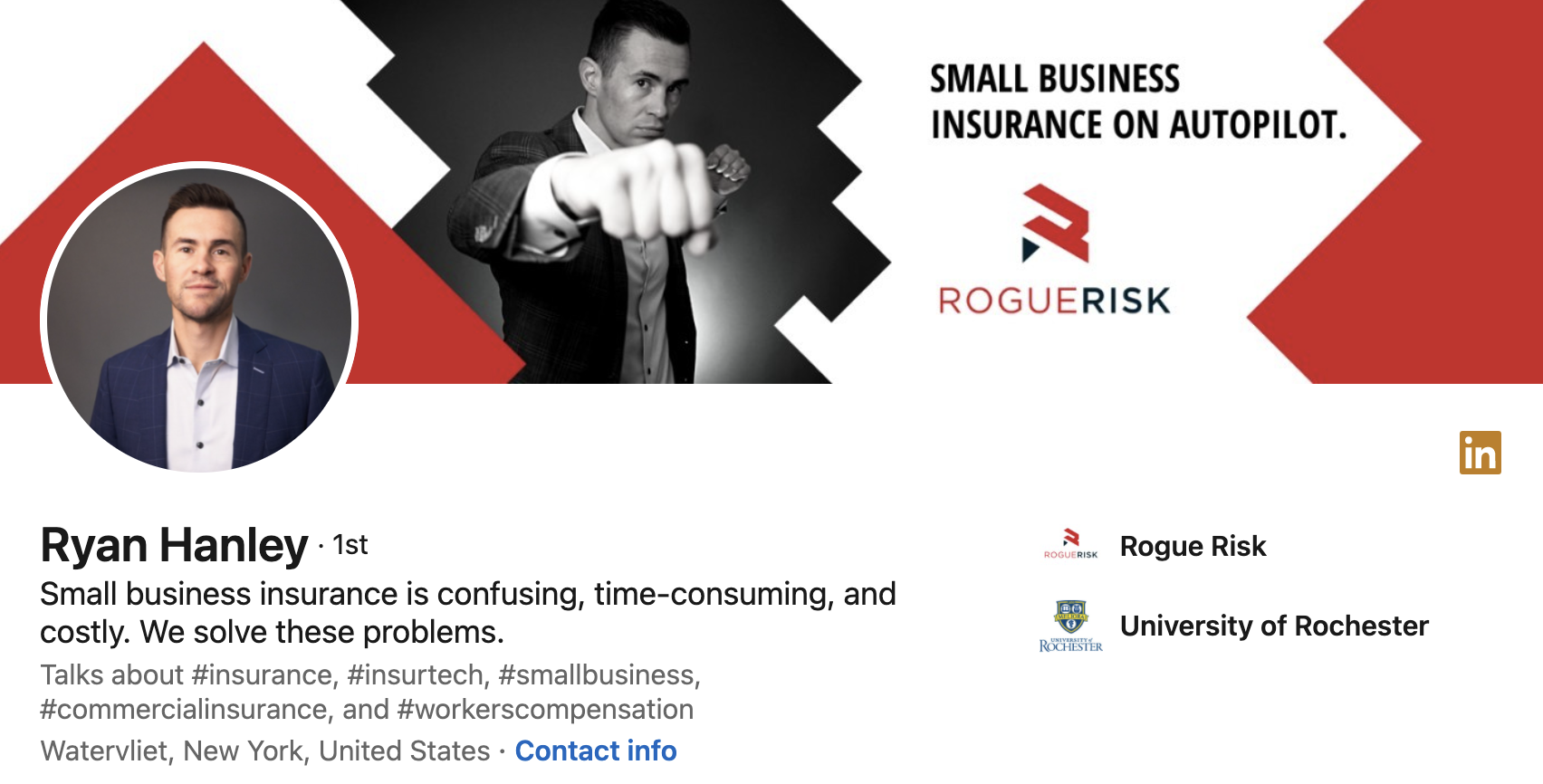
Ryan Hanley takes advantage of the headline field to present a compelling problem/solution. He then wisely includes a number of relevant hashtags in the passage that follows.
Carefully consider keywords to describe yourself and your areas of expertise. You want to be found when people use these words in searches. Showcase your strengths without being pretentious.
Photo
Profiles that include a photo are 11X more likely to be viewed. Your photo should be a high quality headshot. Not a family or vacation shot from your phone.
You’re likely to be making a first impression. Look into the lens, make eye contact and smile.
Background
LinkedIn allows you to upload a background image to serve as your “cover photo.” Choose an image that reflects well on your brand.
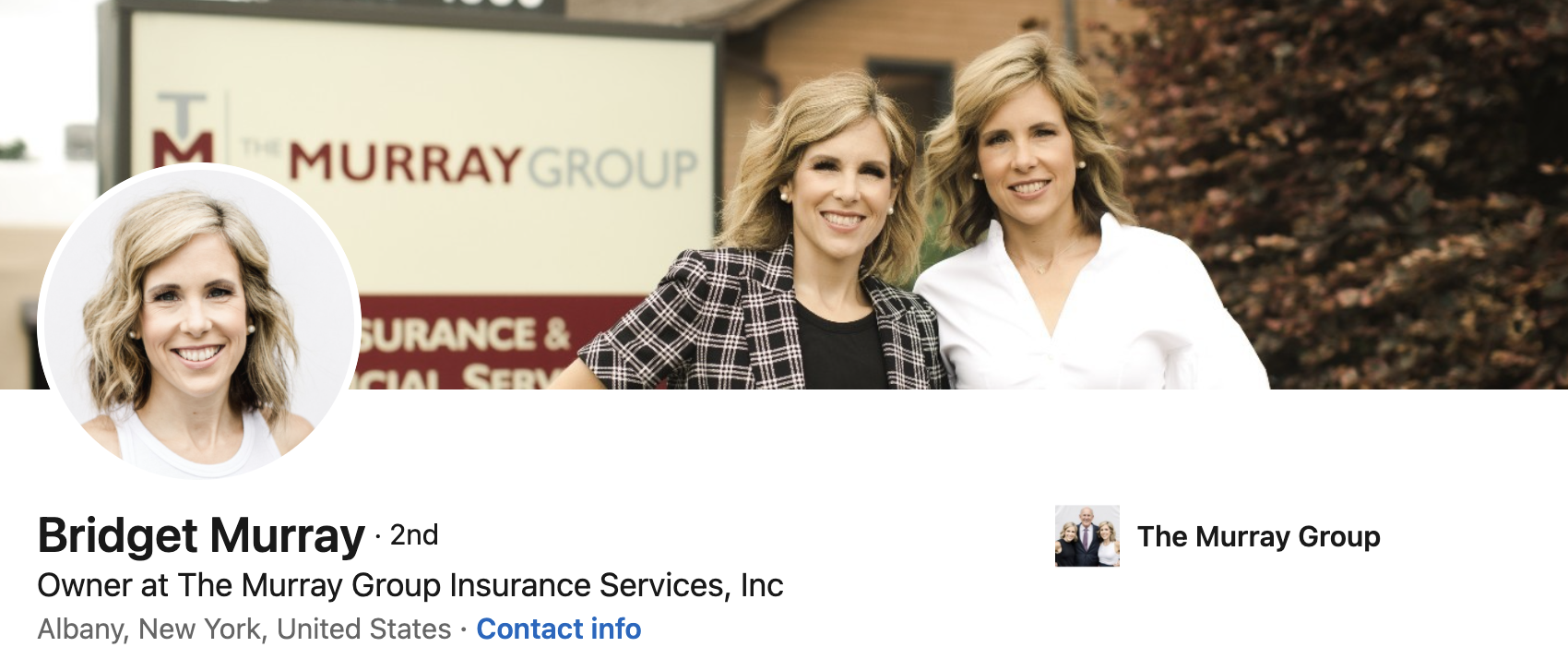
Bridget Murray’s photo and background present her as professional and approachable.
Contact info
The contact information section asks for the usual suspects, but be aware you can override some of the defaults. For instance, you can edit the standard links with the name of your website and blog.
URL
By default, LinkedIn will issue you an impossibly long and anonymous URL. You can, and should, customize it with your name or company name to make it easier to remember and share.
Summary
Use the summary section to tell your story as you would on an “about” page on your website. Include keywords for search purposes, but compose your summary in a warm way aiming to answer basic questions about your skills and inspiring visitors to keep reading.
Showcase your work
LinkedIn makes it easy to showcase any other media assets in your profile’s “Featured” section. I

A wise choice by Kevin Caballaro: featuring a post he wrote to help recently unemployed workers understand their health insurance options.
Experience
Populate the fields in the experience section with your work history to present your credentials as you would in a resume or brochure.
Skills & endorsements
This section allows you to select your skills and present endorsements given to you from LinkedIn members.
Recommendations
Written testimonials are presented here, which are even more powerful than endorsements.
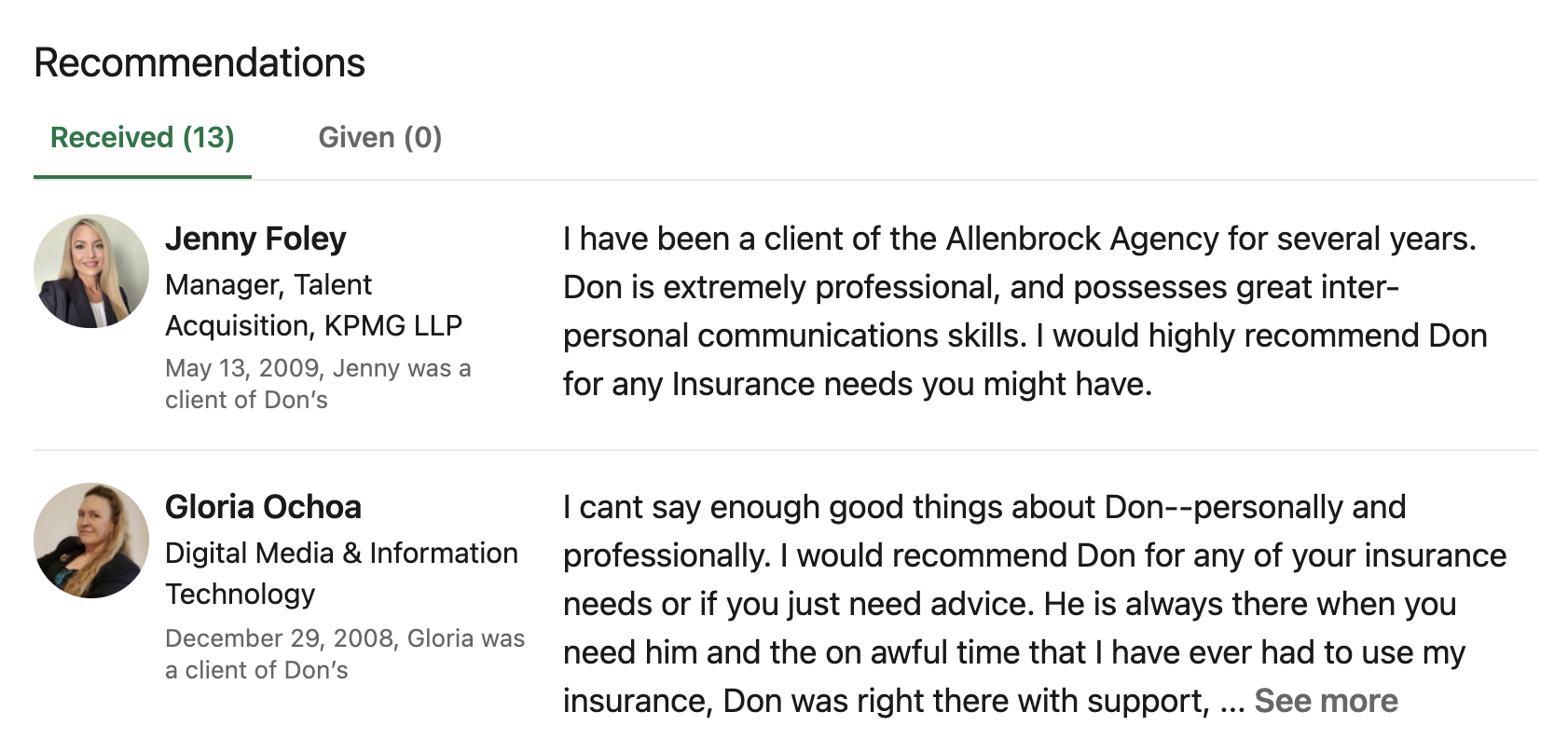
Independent insurance agent/broker Don Scanga, from Denver, presents recommendations from his clients on his profile page.
Additional information and summary elements
A long list of optional sections can be added to your profile: groups, certifications, publications, projects, honors, organizations and more. Publish the things you feel are meaningful credentials and/or conversation starters.
Follow LinkedIn’s lead
The more precise your profile is the better LinkedIn will serve your networking needs by generating the relevant traffic you seek. LinkedIn uses the data from your profile and your networking activity to make proactive suggestions regarding actions you can take to increase your profile views. Suggestions may include groups to join and companies or people to follow. Give the suggestions careful consideration.
Work the network to build relationships
Based on its roots, LinkedIn is often perceived to be a site where job hunters and recruiters meet. It’s true: employment always has been a big part of LinkedIn.
However, the network and what it offers has evolved drastically in recent years. When it comes to professional development, there’s very little you can’t find on LinkedIn.
LinkedIn’s become a leading destination for distributing content and making any kind of connections for:
- Lead generation
- Establishing partnership opportunities
- Conducting research
- Recruitment
- And much more
For all of the above, consider the tips offered below.
Grow your network
Get familiar with the “My Network” section.
Here, LinkedIn does a great good job of populating the list with people you may know (and popular people in your network). You’ll be shown their profile pictures, titles and companies—great starting points for reaching out to make connections.
You can send an automatic invitation with a single click on “connect.” It’s that easy. You can also use LinkedIn automation to scale connection requests.
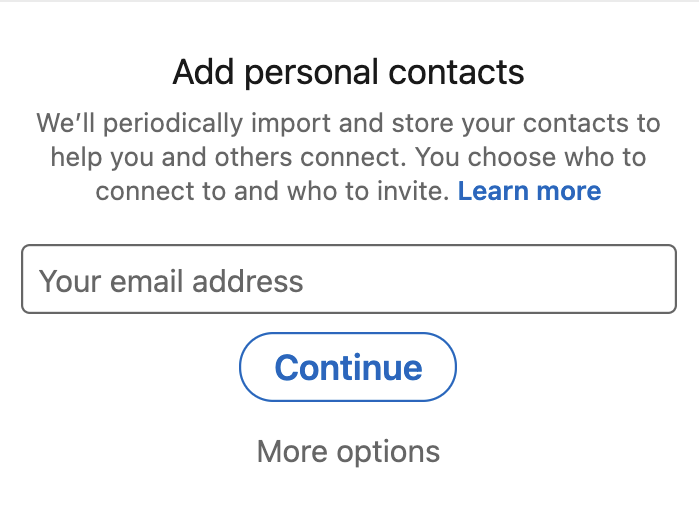
LinkedIn offers a nice widget where you can easily import your email lists.
If you’ve imported your email contacts list via “add personal contacts,” LinkedIn shows you their accounts along with the option to send an invitation by clicking “add connection.”
Other options include:
- Run a people search—and filter it the way you want.
- Set up hashtags to find recommended people and pages.
- Ask for introductions to the people LinkedIn identifies as second degree connections.
In your travels across the network you’ll also come across people you’d like to connect with.
Making a connection request invokes a default email message, which reads “I’d like to connect with you on LinkedIn.” Most members settle for this without a second thought. However, if you’d like to make a memorable first impression, you can—and should—take LinkedIn up on their offer to add a note to personalize your invitation. Put some heart into it.
You can also follow a member, which isn’t exactly the same as connecting.
- When you’re connected, you’ll see each other’s shares and updates on your LinkedIn homepage. You can also send messages to your connections on LinkedIn.
- Following someone allows you to see their posts on your homepage—without being connected. The person you’re following won’t see your posts. You can reach a larger audience by allowing others to follow your activity.
Join groups
One of LinkedIn’s most useful features is LinkedIn Groups. There are millions of groups catering to all business interests. Groups generally exist to share content and ideas. They also provide another way to identify and make meaningful connections.
Use keyword searches to get started finding relevant groups. The results will give you some insights into the group’s charter and also indicate its size by member count. You may also want to examine the profiles of your connections, prospects and clients to see which groups they participate in.
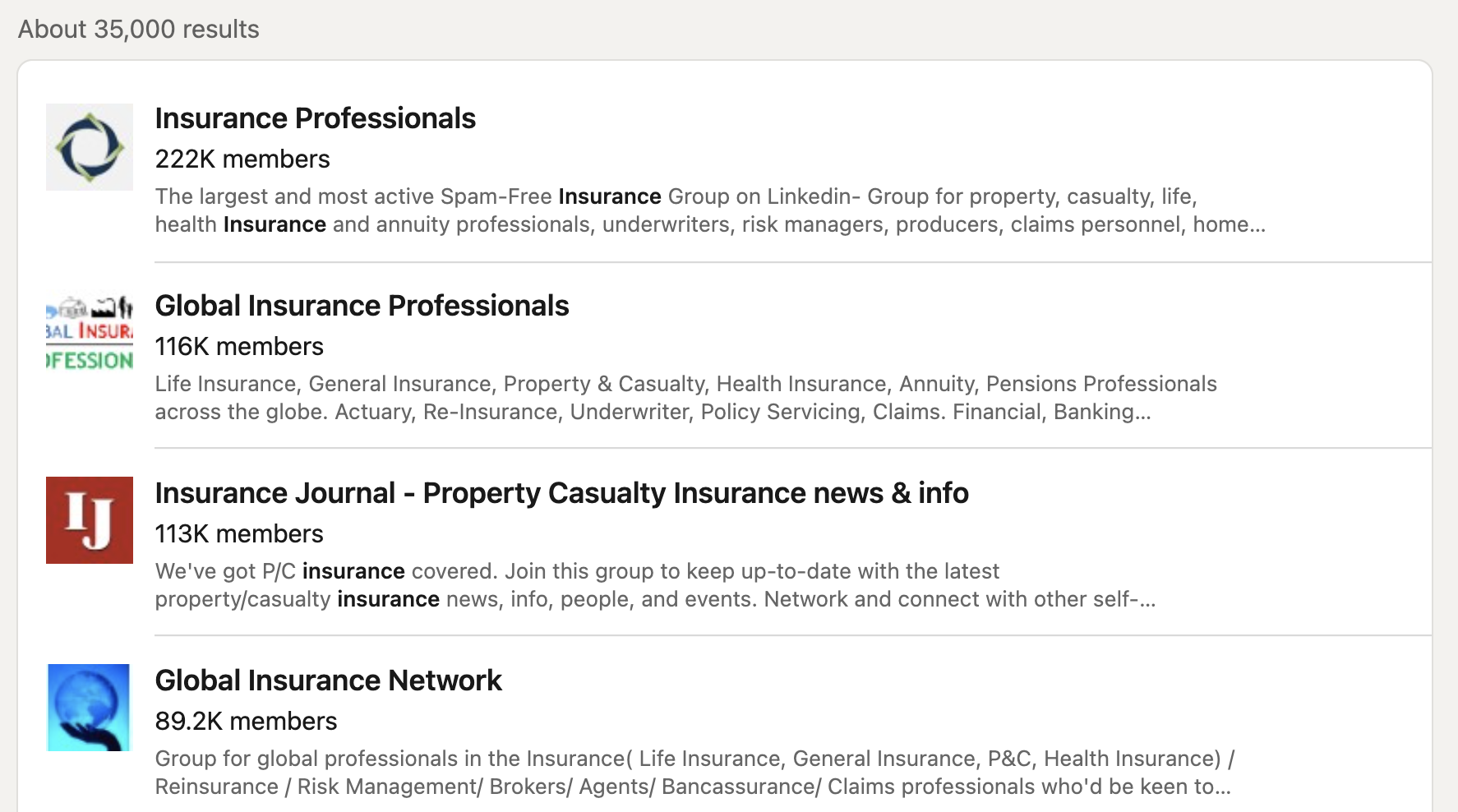
My search in “Groups” for “insurance” produced 35K results. Groups are listed by size. The top four groups here all have over 89K members. Using LinkedIn’s advanced search features, you can filter your results in a variety of ways to help you identify groups you may want to join.
You can join up to 50 groups with a free account. Over time, you’ll find it more meaningful to focus on a small number of active and interesting groups, however you won’t know until you sign-up.
You also have the option to start your own groups, public or private. Creating a group is a cinch, but understand that managing a group takes a fair amount of time.
Stay active
Your level of activity on LinkedIn directly correlates to the profile views you earn. Focus your activity on adding value to your prospects and clients and you’ll see your profile views and connection requests expand.
Endorse your connections
The best way to earn endorsements is by giving them. Take some time each week to endorse your connections. Doing so takes just seconds and you’re bound to find many of your connections will reciprocate.
Say thanks
You know the value of building rapport. An ideal time to do so is immediately after making a new connection. Send personalized thank you messages and offer an overview of your services. Keep it brief and friendly. A smart time-saving strategy is to develop a basic template for thank you notes and personalize each as you see fit.
Promote your presence
Consider adding your LinkedIn profile URL to your email signature as well as offline assets such as your business card and collateral.
Deliver useful content on LinkedIn
By now, you’ve heard of content marketing. You can differentiate your insurance business by publishing valuable content.
Your quest to develop a strong personal brand calls for developing and sharing original content as well as curating content you believe serves the interests of your audience. LinkedIn can become one of your most significant channels to develop your brand with content.
In recent years, through both the development of new features and the integration of services LinkedIn has added by way of acquisitions, the network has become a giant content marketing hub for individuals and companies.
Following are four ideas you’ll want to consider to take advantage of on LinkedIn to support your content marketing.
1. Share your thoughts
As is the case with all social networks, you need to contribute to the conversation. On your LinkedIn home page, “Start a post” presents a blank field in which you can write your thoughts, upload a photo or video, write an article, and include a link if you choose.
A pull-down menu allows you to share your update publicly, strictly with your connections, and via Twitter.
If you’d like to notify a LinkedIn member you’ve mentioned him or her in an update, enter @, followed by the name. The feature also works to mention companies.
2. Start a group discussion
You start discussions within your groups by giving your comment a title and then writing details, which you can designate as “general,” “job” or “promotion.” You cannot add media types here. In some cases, you can include links, however some group moderators discourage or prohibit it.
Link to a blog post, article, ebook, presentation, or whatever is relevant to the discussion you’re starting. Asking questions tends to be the best way to invoke a meaningful discussion. Ask a great question and you may inspire hundreds of responses from members.
Stay tuned-in because your question is likely to beget additional questions. Often, healthy debates follow and you’ll likely want to express your point of view.
3. Go one-on-one
In the course of your updates and discussions you’re likely to want to engage individually. LinkedIn enables you to do so via LinkedIn email. If you’re looking to nurture a “pen pal” relationship into something more, this is how it’s done.
4. Publish articles
In 2014, LinkedIn took a bold step toward becoming a content marketing hub by introducing its own publishing platform.
- LinkedIn created the easiest blog publishing platform anywhere. It’s very intuitive and nice looking too.
- Publishing a blog post—of any length—on LinkedIn is a wonderful opportunity to reach your ideal audience and support your personal brand.
On any given day, a great post stands the chance of getting picked up by LinkedIn’s personalized online magazine, “LinkedIn Pulse,” which often finds a large audience and can inspire many shares and comments.
Another level of LinkedIn
LinkedIn is largely free. However, the company does offer paid services.
LinkedIn Premium accounts
You’ll do fine developing your personal brand on LinkedIn without investing in paid services, however you should be aware premium accounts are offered. The premium offering provides a number of value-added services, some of them are useful to power users. Benefits include:
- Enhanced search features for finding potential connections
- The ability to send messages to any LinkedIn member (InMail)
- Greater visibility across the network
- Access to more profile data
Premium accounts are available to general users and there are specific offerings for recruiters, job seekers and sales professionals.
LinkedIn advertising
LinkedIn’s advertising options are many. The programs offer powerful B2B targeting features to reach the audience you choose among its nearly 700-plus million members.
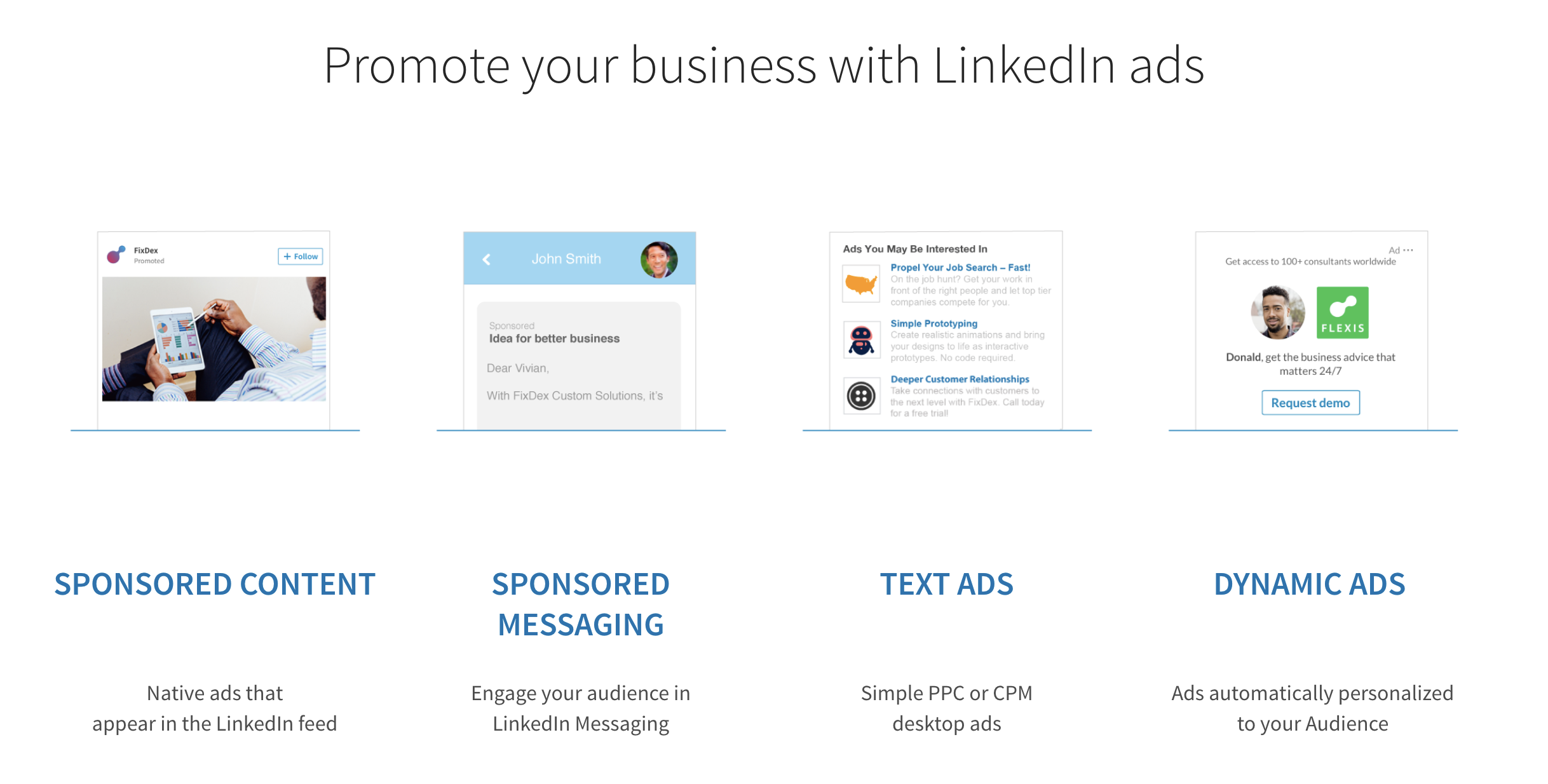
Conclusion: The Brand Called You
Many credit author Tom Peters for creating the term “personal branding” in The Brand Called You, an article he wrote for Fast Company magazine in 1997. In it he wrote:
“The key to any personal branding campaign is ‘word-of-mouth marketing.’ Your network of friends, colleagues, clients, and customers is the most important marketing vehicle you’ve got; what they say about you and your contributions is what the market will ultimately gauge as the value of your brand. So the big trick to building your brand is to find ways to nurture your network of colleagues — consciously.”
If Peters were to update the article today he’d likely say your involvement on LinkedIn is absolutely critical.





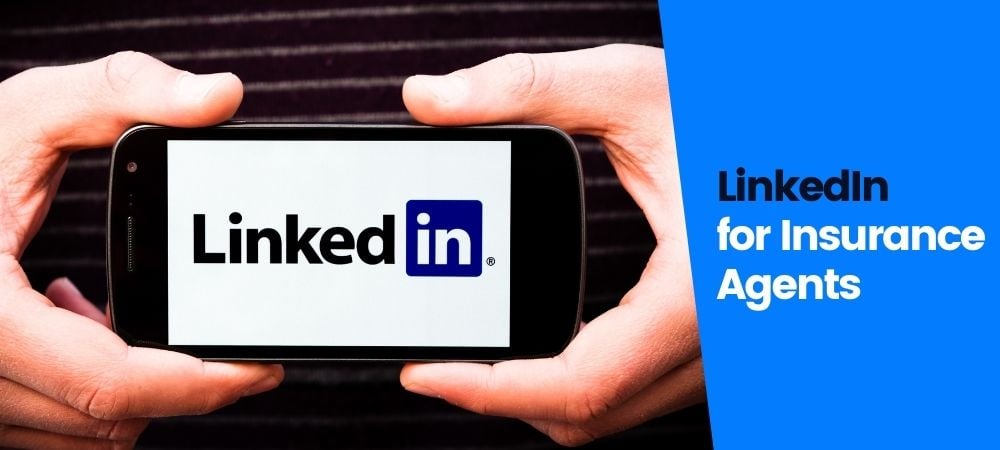


![[EdTech Roundtable Episode 2] Decoding the $30 Bn EdTech Market in India 8 Womens Edtech no CTA 1](https://www.leadsquared.com/wp-content/uploads/2021/11/Womens-Edtech-no-CTA-1-80x80.png)
